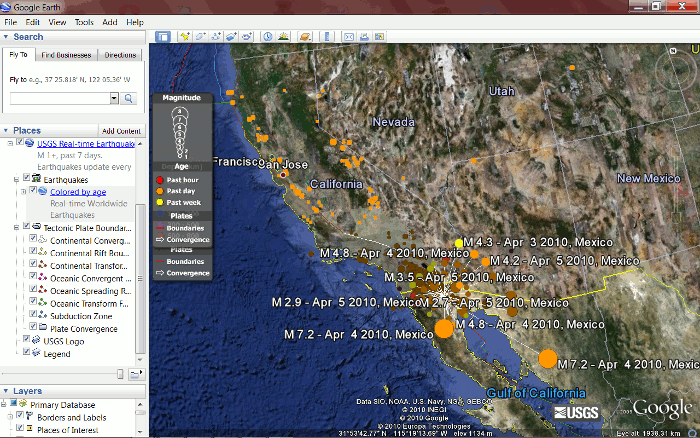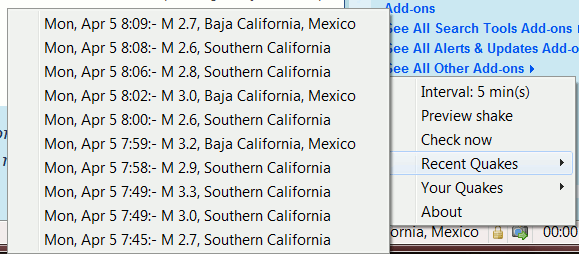If you are looking for up to the minute news on earthquakes it would seem that Twitter beats the mainstream news media even when major shocks have occurred. Phil Bradley has carried out a comparison of the timeliness and quality of information about the Baja 7.2 earthquake provided by Sky News, CNN, ABC, Google News, BBC and Twitter (Phil Bradley’s weblog: Earthquake: Twitter trounces traditional news sources again! http://philbradley.typepad.com/phil_bradleys_weblog/2010/04/earthquake-twitter-trounces-traditional-news-sources-again.html). Not surprisingly Twitter came out on top in terms of speed of reporting but what is amazing is that some people actually tweet while the earthquake is happening. Fine if you are in open countryside but if I was in a built up area I’d be more worried about falling buildings: but then if you are strolling through fields and mountains there is always the possibility that the ground will open up and swallow you. Now that would be worth tweeting about!
If you want up to the minute scientific data on earthquakes, the USGS (US Geological Survey) has a page with a map showing recent tremors and links to RSS feeds giving you date, time, location and magnitude (Earthquakes
http://earthquake.usgs.gov/earthquakes/). They also provide the data as CSV files, an iGoogle gadget and KML feeds for Google Earth.
Google Earth and USGS KML feeds

I have friends and colleagues who live in earthquake zones in New Zealand, China and Turkey. The first major shock is always reported by the press – eventually – as are some of the major aftershocks, but the best way for me to find out what is happening to them is a combination of Twitter and the USGS data. Follow the latter and you will quickly discover that earthquakes are happening somewhere on this planet all of time, most of them of low magnitude. You will also notice that after a major earthquake there are not dozens but hundreds of aftershocks, as I learned from my New Zealand friends. The traditional press have moved on to more interesting stories but the people in the affected region are having to deal with the consequences of not only the first major quake but also the continual aftershocks.
The RSS feeds are good way of keeping up with quake events but I only dip into my feed reader 3 or 4 times a day. Most of my online life is spent in my browser Firefox. Enter the eQuake Alert add-on for Firefox.(https://addons.mozilla.org/en-US/firefox/addon/2239/) This uses USGS data and adds an alert to the status bar of Firefox showing you the magnitude and location of the latest event. Right click on the alert and you can choose to view a list of recent of quakes that also gives you date and time.

As an additional alert there is an option to “Shake browser on earthquake”. This makes your browser screen wobble when news of a quake comes through and you can set it to shake proportional to earthquake magnitude. No chance of missing it now! You can also set a minimum magnitude for alerts, which is useful if you the perpetual wobbling of the screen becomes too intrusive. Mine was originally set to 3 but for hours after the Baja earthquake aftershocks seemed to be occurring every other minute so I increased it to 4
When combined, the different services provide me with a clearer picture of what is going on and help me find out if friends and colleagues have been seriously affected. The Firefox eQuake add-on alerts me to events within a few minutes of their occurrence. The USGS RSS feeds show me what has been happening over the past 24 hours. Twitter provides immediate reports from people in the earthquake zone. Eventually the traditional news media will report and my Google News alerts will kick in. And finally, the USGS KML feeds for Google Earth provide an incredible visualisation of the extent and impact of a series of quakes in a region.